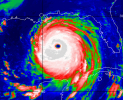Sorting Out Republican Spin on Katrina
Larry Johnson of TPMcafe.com issued this post yesterday that attacks the Republican spin that is trying to shift the blame from the Bush Administration to that of state and local officials in Louisiana, some of which are flat out lies. Here are some highlights:
The Bush White House is furiously spinning to lay the blame on the Governor and Mayor of Louisiana. My position is that I think both the Governor and the Mayor can be faulted on a variety of fronts. I do not absolve them of their responsibility to properly and fully implement their own emergency response plans. However, the Governor followed the appropriate protocol and, in accordance with the National Response Plan (NRP), asked the President in accordance with the Stafford Act, to declare a State of Emergency.
TIMELINE
Sep 07, 2005 -- 02:18:12 PM ESTFriday, 26 August 2005, Governor of Louisiana declares state of emergencySaturday morning, 27 August 2005, Governor of Louisiana asks President Bush to declare a state of emergency and requests Federal Assistance "to save lives and property". Note, the letter was published on 27 August 2005 on Lexis Nexis but was dated 28 August 2005. Bush received the letter on Saturday and responded on the same day by declaring a State of Emergency. Note, per the NRP, William Lokey was designated as the Federal Coordinating Officer for Federal recovery operations in Louisiana.
Sunday, 28 August 2005, Mayor of New Orleans orders Mandatory Evacuation.
(Note: In Governor Blanco's request on the 27th, there is a specific request for help with evacuation and a specific request for help to "save lives and protect property". )
Monday, 29 August 2005, FEMA Director Brown requests DHS Secretary Chertoff's help in getting 1000 DHS employees ready to deploy to the disaster within 48 hours.
Under the National Response Plane (see p. 93, Figure 11), once the President declares a State of Emergency the Department of Homeland Security is supposed to implement the Plan. Initially, DHS is supposed to deploy an Emergency Response Team to the State to provide expertise in assessing needs and determining appropriate courses of action. Moreover, on p. 52 of the NRP the President may act proactively under the Stafford Act.
Folks, these are not OPINIONS, these are cold, objective facts. However, MSNBC and other members of the Main Stream Media are confused about what is a fact and what is opinion.
Now contrast that with this nice visual timeline of the Bush administration's actions leading up to, during, and after the storm hit from Basetree.com:
 UWisc/CIMSS | Gathering Storm |  AP Photo/The White House Eric Draper/File |
Hurricane Katrina hit Florida late Thursday, August 25 and then moved into the Gulf of Mexico, gaining power and momentum. Meteorologists predicted Katrina would hit Louisiana and Mississippi early Monday -- most likely as a Category 4 hurricane. Gulf Coast officials asked residents to evacuate their homes. At 5 PM on Saturday, August 27, New Orleans Mayor Ray Nagin announced a voluntary (later, mandatory) evacuation of the city. Greyhound, Amtrak and airlines halted service late Saturday night. President Bush was vacationing at his Crawford, Texas ranch, perhaps clearing brush as seen in the above August 9 photo. Here is a visual timeline of what happened next: | ||
 Photo by Ted Jackson | August 28 |  AP Photo/Susan Walsh |
 AP Photo/Dave Martin | August 29 |  White House photo by Paul Morse |
 AP Photo/Dave Martin |  Photo by Thomas R. Cordova | |
 AP Photo/David J. Phillip | August 30 |  AP Photo/ABC News Martha Raddatz |
 AP Photo/San Antonio Express-News Jerry Lara | August 31 |  Broadway.com / Bruce Glikas Condoleezza Rice vacations in New York City. (Dick Cheney, on vacation the entire time, is nowhere to be seen.) |
 AP Photo/Eric Gay |  AP Photo/Susan Walsh | |
 Times-Picayune / Brett Duke | September 1 |  AP Photo/ABC News |
 AP Photo/Eric Gay |  AP Photo/Susan Walsh | |
 CNN | September 2 |  CSPAN (Isn't that helicopter needed somewhere?) |
 AFP/POOL/David J. Phillip |  Kevin Lamarque/Reuters | |
 AP Photo/Phil Coale | September 3 |  NY Times / Dennis Brack |
President George W. Bush finds disapproval on his handling of the matter, too -- and the public now shows diminished confidence in his abilities to handle a crisis or provide leadership, as well as in the government's ability to protect the country. RATING THE RESPONSEPresident George W. Bush's overall response to Katrina meets with disapproval today - a dramatic change from the public's reaction just after the storm hit on August 29th. Last week, in the two days immediately after Katrina made landfall, a majority of Americans said they approved of Bush's response, although more than a third were not sure. Now, only 38% approve. A majority disapproves.
BUSH'S HANDLING OF RESPONSE TO KATRINA
Now
Approve Disapprove Don't Know
38% 58% 4%8/30-31
Approve Disapprove Don't Know
This poll was conducted among a nationwide random sample of 725 adults, interviewed by telephone September 6-7, 2005. The error due to sampling for results based on the entire sample could be plus or minus four percentage points.
54% 12% 34%


